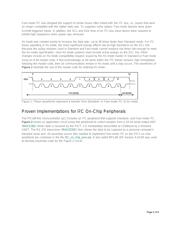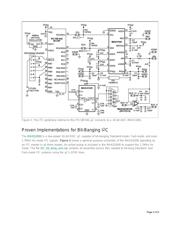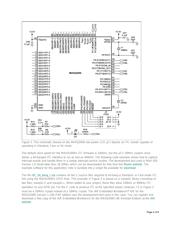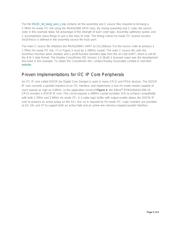herunterladen

Maxim > Design Support > Technical Documents > Reference Schematics > Digital Potentiometers > APP 4267
Maxim > Design Support > Technical Documents > Reference Schematics > Microcontrollers > APP 4267
Keywords: MAXQ2000, I2C
REFERENCE SCHEMATIC 4267
Proven Implementations of the I²C Bus
Sep 11, 2008
Abstract:
This application
note briefly reviews the history of the I
2
C bus. It then presents I
2
C configurations
proven to ensure easy communication between the master and slaves on the bus. Examples include
schematics and code. Appendix 1 contains helpful definitions of terms used in this article.
A similar article was published on the Embedded.com website, August 8, 2007.
Introduction
The Inter IC (I
2
C) bus was developed by Philips Semiconductor in the early 1980s to simplify electronic
products by reducing the number of parallel data lines. Version 1.0 of the I
2
C-bus specification, released by
Philips
®
in 1992, defined a simple, 2-wire, bidirectional bus for communication between ICs. By 1998, the I
2
C
bus had become the de facto standard for low-speed IC-to-IC communications. At that time more than 50
licensed companies were using the standard, and the I
2
C interface was included in more than 1000 different
ICs.
The I
2
C bus configurations presented in this article have been proven to ensure easy communication with
slave devices on the bus. Each implementation includes examples in the form of schematics and code. The
reader should be familiar with the following documents:
The I
2
C-Bus Specification, Version 2.1, January 2000.
Philips Semiconductor document #9398 393 40011.
The I
2
C-bus and how to use it, April 1995.
Philips Semiconductor document #98-8080-575-01.
System Management Bus (SMBus) Specification, Version 2.0, August 2000.
Background and Discussion
The I
2
C bus can operate in Standard mode, Fast mode, or High-Speed (Hs) mode, with maximum data rates
of 100kbps (Standard mode), 400kbps (Fast mode), 1.7Mbps (Hs mode with C
b
= 400pF), and 3.4Mbps (Hs
mode with C
b
= 100pF).
The original Standard mode incorporated 7-bit addressing, which allowed 112 slave addresses. As I
2
C-bus
systems demanded more slave devices, 10-bit addressing was introduced to allocate more slave addresses.
Fast mode added useful features to the slave devices. The maximum data rate was quadrupled to 400kbps.
Page 1 of 8








